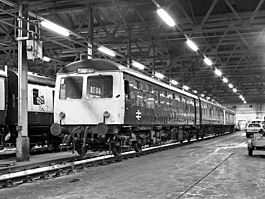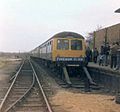British Rail Class 105 facts for kids
Quick facts for kids British Rail Class 105 |
|
|---|---|

Inside Longsight Diesel Traction Maintenance Depot, December 1983
|
|
| In service | 1959-1988 |
| Manufacturer | Cravens Ltd. |
| Constructed | 1956-1959 |
| Formation | 2 or 3 cars per set |
| Operator(s) | British Rail |
| Specifications | |
| Car length | 17.53 m |
| Width | 2.81 m |
| Height | 3.83 m |
| Maximum speed | 70 mph (112 km/h) |
| Weight | 30.5 tonnes |
| Prime mover(s) | Two BUT, 150 bhp |
The British Rail Class 105 was a special type of train called a diesel multiple unit. This means it was a train that could run on its own using a diesel engine, without needing a separate locomotive to pull it. These trains were built by a company called Cravens Ltd. in Sheffield, England, between 1956 and 1959.
Contents
What Was the British Rail Class 105?
The Class 105 trains were part of a big plan to modernize Britain's railways after World War II. They were designed to replace older steam trains on many local and regional routes. These trains were known for their simple, strong design.
How Were They Designed?
The Class 105 trains looked a lot like the regular passenger carriages of the time, known as British Railways Mark 1 coaches. They used the same types of doors and windows, which helped make them easier and cheaper to build. Each train set usually had two or three connected cars.
Who Built These Trains?
The trains were built by Cravens Ltd., a company based in Sheffield. They were one of several manufacturers chosen to help build the new fleet of diesel trains for British Rail. Cravens built these trains from 1956 to 1959.
When Were They Used?
The Class 105 trains started carrying passengers in 1959. They were used all over the country, especially on routes that needed smaller, more flexible trains. These trains were reliable workhorses for many years. They continued to serve passengers until 1988, when the last one was taken out of service. None of these trains were chosen for a major update or "refurbishment" program that some other train types received.
Images for kids
-
A Class 105 train at Fakenham East railway station, Norfolk.
-
A Class 105 at Kings Cross York Rd station in 1976.
-
Looking towards Bures from a Class 105 near Sudbury in 1978.





